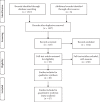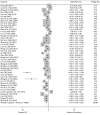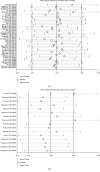Meta-Analysis of Changes in the Number and Proportion of Regulatory T Cells in Patients with Ankylosing Spondylitis
- PMID: 32149142
- PMCID: PMC7053470
- DOI: 10.1155/2020/8709804
Meta-Analysis of Changes in the Number and Proportion of Regulatory T Cells in Patients with Ankylosing Spondylitis
Abstract
Studies on the number and proportion of regulatory T cells (Tregs) in ankylosing spondylitis (AS) patients have been controversial, which has led to a disagreement regarding the role of Tregs in the pathogenesis of AS. To clarify this debate, we conducted a meta-analysis to verify the reported changes in Tregs during AS. We systematically searched the PubMed, Foreign Medical Retrieval System (FMRS), and China National Knowledge Infrastructure (CNKI) web of knowledge databases for eligible articles. A meta-analysis of studies that examined the proportion and number of Tregs among peripheral blood mononuclear cells (PBMCs) and CD4+ T cells was performed using Stata software. Further, subgroup analysis was performed based on Treg definition markers and disease activity to identify potential sources of heterogeneity. Forty-seven studies involving a total of 4373 participants were included in the meta-analysis. The Treg/PBMC and Treg/CD4+ T cell ratios were significantly lower in AS patients than those in healthy controls (HCs). A subgroup analysis indicated that patients defined by CD4+CD25+/high, CD4+CD25+CD127low/-, and CD4+CD25+FOXP3+ had much lower Treg/PBMC and Treg/CD4+ T cell ratios than HCs. Active AS patients also had a substantially lower proportion of Tregs/PBMCs and Treg/CD4+ T cells than HCs. The proportion of Tregs among both PBMCs and CD4+ T cells was significantly decreased in AS patients. Treg definition markers and disease activity may influence the proportion of Tregs measured among the PBMC and CD4+ T cell populations. Further study of the correlation between AS disease activity and the proportion of Tregs in peripheral blood is needed to determine the physiological role of this association. This study implies that loss of Tregs may play a role in the pathogenesis of AS and helps clarify the contradictory Treg results in AS patients. This trial is registered with PROSPERO (CRD42019147064).
Copyright © 2020 Ming Li et al.
Conflict of interest statement
The authors declare that there are no conflicts of interest regarding the publication of this paper.
Figures





Similar articles
-
Imbalance of Peripheral Lymphocyte Subsets in Patients With Ankylosing Spondylitis: A Meta-Analysis.Front Immunol. 2021 Jul 6;12:696973. doi: 10.3389/fimmu.2021.696973. eCollection 2021. Front Immunol. 2021. PMID: 34295337 Free PMC article.
-
Regulatory T-cell levels in systemic lupus erythematosus patients: a meta-analysis.Lupus. 2019 Apr;28(4):445-454. doi: 10.1177/0961203319828530. Epub 2019 Feb 11. Lupus. 2019. PMID: 30744525
-
The Proportion of Regulatory T Cells in Patients with Ankylosing Spondylitis: A Meta-Analysis.J Immunol Res. 2019 Oct 23;2019:1058738. doi: 10.1155/2019/1058738. eCollection 2019. J Immunol Res. 2019. PMID: 31772947 Free PMC article. Review.
-
The proportion of regulatory T cells in peripheral blood of patients with autoimmune hepatitis: A systematic review and meta-analysis.Int Immunopharmacol. 2023 Sep;122:110576. doi: 10.1016/j.intimp.2023.110576. Epub 2023 Jun 28. Int Immunopharmacol. 2023. PMID: 37390643
-
[Inhibition of CD4+ CD25+ regulatory T cells in chronic hepatitis B patients].Zhonghua Yi Xue Za Zhi. 2008 Feb 26;88(8):511-5. Zhonghua Yi Xue Za Zhi. 2008. PMID: 18649763 Chinese.
Cited by
-
Beyond the horizon: Innovations and future directions in axial-spondyloarthritis.Arch Rheumatol. 2023 Nov 22;38(4):491-511. doi: 10.46497/ArchRheumatol.2023.10580. eCollection 2023 Dec. Arch Rheumatol. 2023. PMID: 38125058 Free PMC article. Review.
-
Features of Peripheral Blood Th-Cell Subset Composition and Serum Cytokine Level in Patients with Activity-Driven Ankylosing Spondylitis.Pharmaceuticals (Basel). 2022 Nov 8;15(11):1370. doi: 10.3390/ph15111370. Pharmaceuticals (Basel). 2022. PMID: 36355542 Free PMC article.
-
Efficacy of alendronate for the treatment of ankylosing spondylitis: A protocol for systematic review and meta-analysis.Medicine (Baltimore). 2020 Jul 24;99(30):e21089. doi: 10.1097/MD.0000000000021089. Medicine (Baltimore). 2020. PMID: 32791682 Free PMC article.
-
Role of the microbiome and its metabolites in ankylosing spondylitis.Front Immunol. 2022 Oct 13;13:1010572. doi: 10.3389/fimmu.2022.1010572. eCollection 2022. Front Immunol. 2022. PMID: 36311749 Free PMC article. Review.
-
Imbalance of Peripheral Lymphocyte Subsets in Patients With Ankylosing Spondylitis: A Meta-Analysis.Front Immunol. 2021 Jul 6;12:696973. doi: 10.3389/fimmu.2021.696973. eCollection 2021. Front Immunol. 2021. PMID: 34295337 Free PMC article.
References
Publication types
MeSH terms
Substances
LinkOut - more resources
Full Text Sources
Medical
Research Materials

